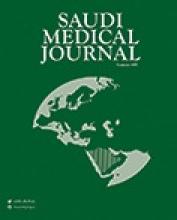Abstract
OBJECTIVE: To analyze the causes of uveitis and compare our results with national and international published studies.
METHODS: This is a retrospective review of medical records of patients who attend the uveitic clinic of Magrabi Eye and Ear Hospital in Jeddah, Kingdom of Saudi Arabia from January 1999 to December 2011.
RESULTS: We encountered 823 eyes of 587 uveitis patients (male: 319 [54%] and female: 268 [46%]). Native Saudi patients constituted 52% of our total population, expatriate Arabs 23%, and Afro-Asians 23%. Average age at presentation was 34.8+/-12.83 (range 5-70) years. Unilateral presentation was noted in 351 (60%) and bilateral in 236 (40%) patients. Idiopathic anterior uveitis was the most common diagnosis (n=268, 45.7%). Anterior uveitis was the most common anatomical diagnosis (n=335, 57.1%) followed by panuveitis (n=151, 25.7%), posterior uveitis (n=51, 8.7%) and intermediate uveitis (n=50, 8.5%). There were 50 patients (8.5%) of Behcet’s disease, 48 patients (8.2%) of Vogt-Koyanagi-Harada disease (VKH) and 35 cases (6%) of toxoplasmosis.
CONCLUSION: The most common cause of anatomic diagnosis was anterior uveitis. Behcet’s disease was the most common identifiable cause of uveitis followed by VKH. The most common cause of infectious uveitis was toxoplasmosis. Idiopathic anterior uveitis was the most common uveitic entity.
- Copyright: © Saudi Medical Journal
This is an open-access article distributed under the terms of the Creative Commons Attribution-Noncommercial License (CC BY-NC), which permits unrestricted use, distribution, and reproduction in any medium, provided the original work is properly cited.






